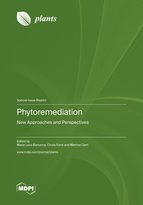Phytoremediation: New Approaches and Perspectives
A special issue of Plants (ISSN 2223-7747). This special issue belongs to the section "Plant–Soil Interactions".
Deadline for manuscript submissions: closed (30 June 2022) | Viewed by 37461
Special Issue Editors
Interests: phytoremediation; agrochemicals; xenobiotic detoxification; defensive enzymes; plant nutrition; biostimulants
Interests: abiotic stress response in plants; the production of secondary metabolites in vivo and in vitro; plant-growth-promoting bacteria; phytoremediation
Special Issues, Collections and Topics in MDPI journals
Interests: plant anatomy; plant physiology; plant reproduction; electron microscopy; immunohistochemistry
Special Issues, Collections and Topics in MDPI journals
Special Issue Information
Dear Colleagues,
Environmental pollution is a widespread problem that humans must prevent and counteract to ensure the wellbeing of all species on our planet. Among the methods used to decontaminate polluted water and soil, phytoremediation is highly regarded for its effectiveness and ecofriendliness. This technology uses plants capable of removing pollutants from the growing medium. Some plant species, possibly together with their associated microorganisms, have been proven to absorb and/or degrade large amounts of contaminants, without their vital functions being compromised. Usually, these plant species constitutionally possess high levels of antioxidant or detoxifying molecules, which can be further induced in response to the accumulation of xenobiotics. The phytoremediation techniques currently applied are many, and the range of pollutants that are successfully removed or made less harmful is vast. Nevertheless, many processes behind this technology remain to be elucidated. In addition, new approaches can be used to increase the performance of this technique or to broaden its horizon of application.
Given the importance of these themes in relation to the global challenges of environmental sustainability, this Special Issue of Plants aims to expand knowledge in this field.
Dr. Maria Luce Bartucca
Prof. Dr. Cinzia Forni
Dr. Martina Cerri
Guest Editors
Manuscript Submission Information
Manuscripts should be submitted online at www.mdpi.com by registering and logging in to this website. Once you are registered, click here to go to the submission form. Manuscripts can be submitted until the deadline. All submissions that pass pre-check are peer-reviewed. Accepted papers will be published continuously in the journal (as soon as accepted) and will be listed together on the special issue website. Research articles, review articles as well as short communications are invited. For planned papers, a title and short abstract (about 100 words) can be sent to the Editorial Office for announcement on this website.
Submitted manuscripts should not have been published previously, nor be under consideration for publication elsewhere (except conference proceedings papers). All manuscripts are thoroughly refereed through a single-blind peer-review process. A guide for authors and other relevant information for submission of manuscripts is available on the Instructions for Authors page. Plants is an international peer-reviewed open access semimonthly journal published by MDPI.
Please visit the Instructions for Authors page before submitting a manuscript. The Article Processing Charge (APC) for publication in this open access journal is 2700 CHF (Swiss Francs). Submitted papers should be well formatted and use good English. Authors may use MDPI's English editing service prior to publication or during author revisions.
Keywords
- environmental pollution
- contaminants
- xenobiotics
- detoxification
- antioxidants
- hyperaccumulators
- plants
- microbes
- wastewater









